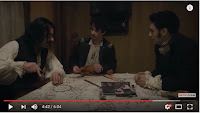Here is a mind map abount typical genre conventions.
GENRE AND STYLE
Our chosen genre was fantasy mockumentary, and we used many genre conventions (as noted in the above mind map) to convey the mockumentary style we wanted to achieve.
 |
| Trollhunter (2010). |
 |
| What We Do In The Shadows (2014). |
A common convention in mockumentaries is to use interview set ups with a character interview talking to an interviewer or just the camera. Trollhunter has interview set ups where the characters tell the audience information, while it still seems like an average shot (there are no inter titles/graphics, etc). However, What We Do In The Shadows has a more obvious interview set up, where the characters are sitting in one side of the frame, directly talking to the camera, mimicking interviews in real documentaries. We have gone with the obvious interview set up for our film, as we decided to fulfil the expectations of the genre in an almost tongue-in-cheek style.
 |
| Interview set up in A Sight For Sore Eyes (2017). |
 |
| Waiting For Guffman (1996). |
 | ||
| What We Do In The Shadows (2014). |
The lighting and grading used in both Waiting For Guffman and What We Do In The Shadows is naturalistic to portray the documentary style. In What We Do In The Shadows, the lighting is dark, with very matte tones, as it works well with their vampire theme. However, Waiting For Guffman uses more everyday lighting with minimal grading, as it represents 'normal' life settings to relate more to the audience, whilst copying the documentary style. A Sight For Sore Eyes also uses natural lighting that you would find in an average home, as it better represents the characters and settings, and also portrays the genre.
 |
| A Sight For Sore Eyes (2017). |
Another convention is the use of jump cuts. This puts emphasis on the unplanned documentary style of the film and is also really convenient. We have used it because we did a lot of our takes with character improvisation to give it the naturalistic feel, so we had to make some jump cuts, as well as to follow the conventional documentary-style of our chosen genre.
What We Do In The Shadows (2014)
A Sight For Sore Eyes (2017)
Here is a presentation about the theories we looked at.


No comments:
Post a Comment